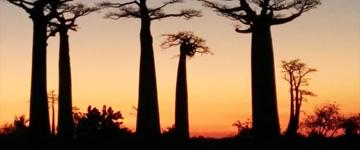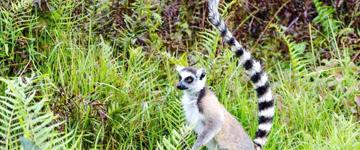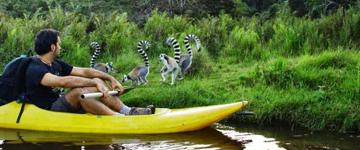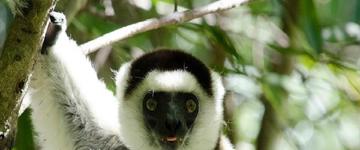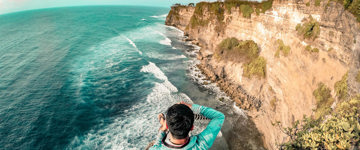Wild Madagascar
Most people only know Madagascar from the animated children’s movie of the same name. In the movie, a giraffe, a lion, and a zebra find themselves stranded on the strange island. When you come to the real country, you won’t find any giraffes, lions or zebras, but you will find an enormous amount of animals and plants that cannot be seen anywhere else in the world. Madagascar is the fourth largest island in the world and lies 300 miles east of southern Africa. Geologists believe that Madagascar was connected to Africa about 165 million years ago, and then started to drift out to sea sometime in the next 15 million years. This geographic isolation has given the plant and animal life on the island time to evolve separately from species in the rest of the world. There are approximately 200,000 plant and animal species living on the island, and about 150,000 of those species are endemic, meaning they don’t exist anywhere else.

Once in a Lifetime Wildlife
Madagascar is considered to be a “megadiverse” country by Conservation International, because it is home to more than half of the world’s chameleons and dozens of endemic species of lemur. There is so much exciting wildlife to discover on the island that will never be found anywhere else. In Madagascar you can see both the Parson’s chameleons, which is the largest chameleon in the world, and the dwarf chameleons of Brookesia, which is the smallest in the world. While searching plants, leaves and low branches for chameleons and other lizards, don’t forget to look up to catch any of the 70 species of lemur bouncing from tree to tree, or curled up for a nap wrapped in their long fuzzy tails. If you’re lucky, you may even spot an aye-aye, a Madagascar long-eared owl, or a satanic leaf tailed gecko.

It isn’t just the animals that are unique and exciting. The country is also home to countless endemic plants. The most famous is the baobab tree. Known by locals as the ‘upside down tree,’ the baobab can grow to be 10-40 meters tall and 6 meters wide. The trees can live for thousands of years, and are important sources of water for locals during the dry season. When exploring the baobab forests near Andavadoaka in the southwest region of the country, you will see some of the trees have large cut outs near the base. Baobab trees can store 650 liters of water per cubic meter. During the long dry season, animals will chew on the bark and humans will extract water through the hollowed out parts of the base of the tree. These extremely unique trees are essential to survival for many people and animals in Madagascar. The varying forests are full of plants and trees that offer life saving and medicinal purposes. Besides the baobab forests, be sure to spend time getting to know the spiny forests, which are of course full of very spiky plants, such as the octopus trees. Explore these natural reserves with a local guide who can tell you all about the life saving properties of the plants around you. The Arboretum in the small city of Tulear is a great place to learn about the various plant life from all over the country.

Protecting Wildlife
Exciting and unique wildlife is not just restricted to land in Madagascar. The fifth largest coral reef in the world, The Great Reef, runs 450km along the southwestern coast of Madagascar. Whether you’re a snorkeler or diver, don’t miss the opportunity to get to know the underwater wildlife this country has to offer. Unfortunately, the reefs in Madagascar are rapidly dying due to climate change and overfishing. One easy way to do your part to protect the reef during your visit is to choose not to eat fish. Many villagers in the area have no choice but to eat fish as that is the only food they have access to. With the rapid decrease in fish populations, many families along the coastlines are going hungry. If you have the choice, skip the fish and leave them in the sea for those who really need them. Another easy way to protect the magnificent sea life is to wear only reef safe sunscreen. Toxic chemicals in traditional sunscreens play a big part in coral bleaching. If you’re in Andavadoaka and you’d like to learn more about our oceans, how they’re being threatened by climate change and what we can do, walk over to Blueventures, just a few minutes away from Coco Beach. The scientists and volunteers there will likely be happy to answer any questions you have. When exploring the forests and other land ecosystems, remember that they too are being greatly affected by climate change. Don’t be afraid to ask your local guides questions about the effects they’re seeing and ways your impact can be mitigated.
Madagascar is a country unlike any other. It is similar to the Galapagos in its isolation and subsequent development of entirely unique plant and animal species. This incredibly diverse country has so much to explore, and so many creatures in need of protection. One of the best ways to experience this incredible island is on a tour with a local guide. Whether you’re looking for a once in a lifetime wildlife experience, or some interesting, unknown history, Madagascar is a wild destination sure to impress even the most picky traveler.

Dara is avid scuba diver, book worm, and vegetarian foodie with a deep passion for conservation. Her favorite countries so far are Greece, Bosnia and South Africa. She loves writing about anything that encourages people to get outdoors, try something new, and live more sustainably.
